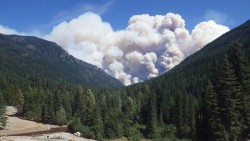
Recent years have brought unusually large and damaging wildfires to the Pacific Northwest – from the Carlton Complex Fire in 2014 that was the largest in Washington’s history, to the 2017 fire season in Oregon, to the 2018 Maple Fire, when normally sodden rainforests on the Olympic Peninsula were ablaze. Many people have wondered what this means for our region’s future.
A University of Washington study, published this winter in Fire Ecology, takes a big-picture look at what climate change could mean for wildfires in the Northwest, considering Washington, Oregon, Idaho and western Montana.
“We can’t predict the exact location of wildfires, because we don’t know where ignitions will occur. But based on historical and contemporary fire records, we know some forests are much more likely to burn frequently, and models can help us determine where climate change will likely increase the frequency of fire,” said lead author Jessica Halofsky, a research scientist at the UW School of Environmental and Forest Sciences and with the U.S. Forest Service.
The review was done in response to a survey of stakeholder needs by the Northwest Climate Adaptation Science Center, a UW-hosted federal–university partnership. State, federal and tribal resource managers wanted more information on the available science about fire and climate change.
“We’re on the cusp of some big changes. We expect that droughts will become more common, and the interaction of climate and fire could look very different by the mid-21st century,” said David Peterson, professor at the UW School of Environmental and Forest Sciences. “Starting the process of adapting to those changes now will give us a better chance of protecting forest resources in the future.”
The greatest increased risk was found for low-elevation ponderosa pine forests, of the type found at lower elevations on the east side of the Cascade Range in Washington, Oregon, Montana and Idaho. This ecosystem has the highest fire risk today and also has the highest increase in risk due to climate change. The authors predict with high confidence that wildfires in this region will become larger and more frequent.
“We can’t attribute single fire events to climate change. But the trends in large fire events that have been occurring in the region are consistent with expected trends in a warming climate,” said co-author Brian Harvey, assistant professor at the UW School of Environmental and Forest Sciences. His UW research group studies forests and fires in the Pacific Northwest and Northern Rockies.
Read more at UW News »
